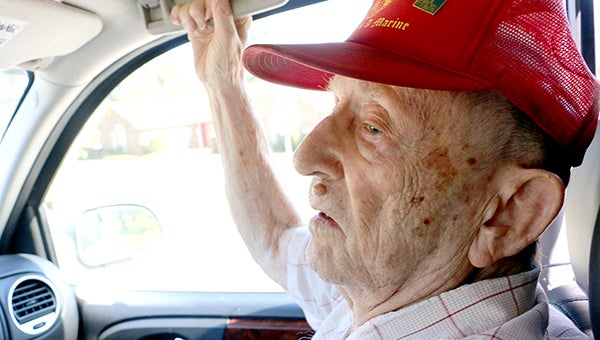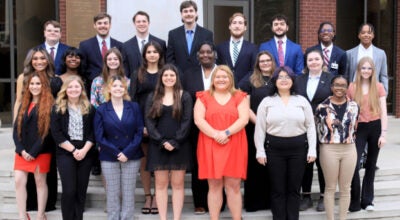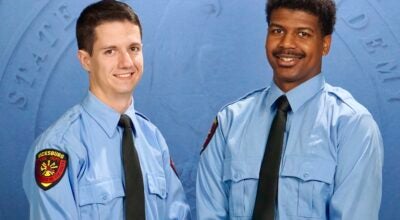Westbrook: We just did what we had to do
Published 12:08 pm Wednesday, November 2, 2016

- SEMPER FI: Former Marine Jim Westbrook served during World War II and took part in some of the most iconic battles in the Pacific theater in Saipan and Iwo Jima. (Ariel Cobbert | The Vicksburg Post)
By Lyndy Berryhill
The Vicksburg Post
Most people don’t live to be 93 years old and most people didn’t survive the bloodiest battle in Marine history, but Jim Westbrook isn’t most people.
His life began to change on Dec. 7, 1941. He was playing touch football in his hometown of Houston, Miss. It was a quiet Sunday until a friend interrupted the game with the news of Japan’s sneak attack on the U.S. Naval Base at Pearl Harbor.
“The war will be over in no time,” Westbrook told his friends. “Why not?”
After all, his father had helped “whip the Germans” in France during World War I and that only took two years. Westbrook had no reason to doubt this war would take any longer. But it did. And Westbrook grew weary of waiting for victory. On March 4, 1943, he enlisted.
The only marching experience Westbrook had was in his high school band, but now he was going to march to the beat of a Pacific war drum instead of a snare.
He was placed with the soon-to-be famed “Fighting 4th” division. It was the only Marine division that went directly into combat from training in the U.S.
He left training at Camp Shelby on a six-day train ride to San Diego with his fellow servicemen on Jan. 13, 1944.
Westbrook’s division was sent to Maui, Hawaii, then to a variety of Islands before attacking Saipan. Before the bloody hand-to-hand battle was done, Marines had nicknamed two of the hot spots “Death Valley” and “Purple Heart Ridge.”
“We didn’t get shot at all the time,” Westbrook said. “The worst thing we feared was artillery and mortar fire…you learn to avoid the stuff you can.”
Staying safe was not easy for anyone. It was extra hard for Westbrook. He was a radio operator and as much as he was shot at, he did not often get to shoot back. The radio he carried on his back weighed nearly 40 pounds and had a 5-foot antenna, a clear moving target for Japanese snipers.
Too many times he saw bullets before his eyes.
Even today, sitting in his living room, Westbrook remembers the sights and sounds of battle at Iwo Jima.
“Tat-tat-tat-tat-tat” Westbrook shouts, mimicking the lethal rattle of machine gun fire.
He learned how to pray in the Pacific. After he dug a foxhole in the burning hot volcanic sand, eerily similar to a shallow grave, Westbrook had no tiny book of stale prayers to recite. He had to come up with his own words when he talked to God in the foxhole.
“The good Lord was looking out for me,” Westbrook said. “I fully believe that. I know my mama was doing a lot of praying at home.”
The day the iconic American flag went up in the black sand atop Mount Suribachi, Westbrook reveled in the roaring cheers that erupted all over the 9-square-mile volcanic island.
He still remembers the distinctive sweet, sharp aroma of cordite mixing with the sulphuric smell of the island sand.
The battle lasted 35 days. Afterwards only 12 of the original 250 men in his division remained. Twice, the Marines had to rush fresh men to the beaches and thrust them into the raging battle.
Westbrook survived his years of service with only minor injuries. One of 26,000 casualties at Iwo Jima, he went home with a small piece of shrapnel he picked up in Saipan and a bullet wound on his arm. Westbrook had to dig the bullet out himself. The shot was later discovered to be “friendly fire” from a fellow Marine’s ricochet.
To Westbrook, none of the movies come close to depicting what it was really like.
“I saw The Sands of Iwo Jima with John Wayne,” he said shaking his head.
The scene where John Wayne holds his rifle up and yells, “Come on you sons of bitches, let’s go! Did you expect to live forever?!” Westbrook said would have never happened.
“That ain’t the way it is,” Westbrook said. “You knew damn well you were trying to live.”
Too many failed. Seven thousand Marines perished.
Westbrook came home. He set out to resume a normal life. He graduated with a degree in accounting, took a job with an insurance company and retired close to 30 years ago.
These days he watches football with his wife Grace, waiting in-between visits from children, grandchildren and great-grandchildren. In his retirement he has served as president of the Fourth Marine Division Association of World War II.
When he talks of war, he never uses the word “bravery,” or the fact he was awarded the Purple Heart, on display at the Southern Heritage Air Foundation museum in Mound, La.
His blue eyes, once trained to scan his surroundings for the enemy, are now legally blind.
He can still see enough to get around his home, but his handicaps haven’t dampened his patriotism. When he crosses the Mississippi River bridge he knows the American flag still flies at the top.
“I fought for that,” Westbrook says, looking up.
His service is summed up on one of the commemorative bricks at the National World War II Museum in New Orleans. Westbrook, one Marine out of 16.1 million servicemen who served in World War II, helped pave the way to victory in 1945.
But he recoils at the word hero.
“We just did what we had to do,” he said.
SPECIAL SERIES: This story is part of a series of articles featuring local veterans and their stories. The stories were written by journalism students from the University of Mississippi and is sponsored by Trustmark Bank.





